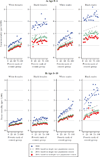Mortality Inequality: The Good News from a County-Level Approach
- PMID: 27917023
- PMCID: PMC5134744
- DOI: 10.1257/jep.30.2.29
Mortality Inequality: The Good News from a County-Level Approach
Figures







References
-
- Almond Douglas, Currie Janet. Human Capital Development Before Age Five. In: Card David, Ashenfelter Orley., editors. Handbook of Labor Economics. 4B. Amsterdam: Elsevier; 2011. Chapter 15.
-
- Arias Elizabeth, Schauman William S, Eschbach Karl, Sorlie Paul D, Bucklund Eric. Vital and Health Statistics Series 2. 148. National Center for Health Statistics; 2008. Oct, The Validity of Race and Hispanic Origin Reporting on Death Certificates in the United States. - PubMed
-
- Banks James, Marmot Michael, Oldfield Zoe, Smith James P. Disease and Disadvantage in the United States and in England. JAMA. 2006;295(17):2037–2045. - PubMed
Publication types
MeSH terms
Grants and funding
LinkOut - more resources
Full Text Sources
Other Literature Sources
Medical
